Types of Refractory Materials Used in Different Parts of Heating Furnaces
Types of Refractory Materials Used in Different Parts of Heating Furnaces Heating furnaces are essential equipment in industries such as metallurgy, petrochemical, and machinery manufacturing. Operating under extreme high temperatures and harsh working conditions, these furnaces demand reliable and long-lasting refractory materials to ensure thermal insulation, mechanical strength, and operational safety. However, not all furnace areas face the same thermal and chemical stresses, which is why different zones require different types of refractories. At Rongsheng Refractory, we offer a full…



